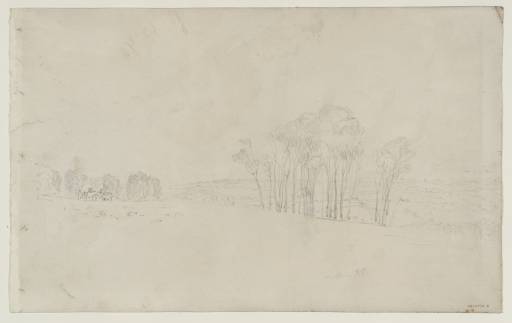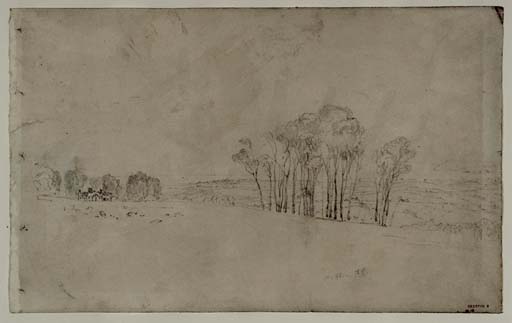Joseph Mallord William Turner Crowhurst Park 1810
Image 1 of 2
Joseph Mallord William Turner,
Crowhurst Park
1810
Joseph Mallord William Turner 1775–1851
Crowhurst Park 1810
D10327
Turner Bequest CXXXVIII 8
Turner Bequest CXXXVIII 8
Pencil on white wove paper, 200 x 323 mm
Inscribed ?by John Ruskin in red ink ‘8’ bottom right
Stamped in black ‘CXXXVIII 8’ bottom right
Inscribed ?by John Ruskin in red ink ‘8’ bottom right
Stamped in black ‘CXXXVIII 8’ bottom right
Accepted by the nation as part of the Turner Bequest 1856
Exhibition history
1998
Turner in 1066 Country, Hastings Museum and Art Gallery, Hastings, September–November 1998 (14).
References
1909
A.J. Finberg, A Complete Inventory of the Drawings of the Turner Bequest, London 1909, vol.I, p.397, CXXXVIII 8.
1979
Andrew Wilton, The Life and Work of J.M.W. Turner, Fribourg 1979, p.348.
1981
Eric Shanes, Turner’s Rivers, Harbours and Coasts, London 1981, p.152.
1998
Eric Shanes, Turner in 1066 Country, exhibition catalogue, Hastings Museum and Art Gallery, Hastings 1998, p.21.
2001
Andrew Wilton in Wilton, Inge Bodesohn-Vogel and Helena Robinson, William Turner: Licht und Farbe, exhibition catalogue, Museum Folkwang, Essen 2001, p.310.
This drawing served as the basis for the watercolour Pevensey Bay, from Crowhurst Park made circa 1813 for John Fuller (private collection)1 and engraved by William Bernard Cooke in 1816 for Views in Sussex. The view is towards Bexhill and around Pevensey Bay to Beachy Head. Martello towers are visible along the distant shore. Crowhurst Park, which stands on the left, as the seat of Henry Pelham, Crown Commissioner for Customs. His kinsman the Hon. Charles Pelham bought Turner’s Wreck of a Transport Ship (Fundaçao Calouste Gulbenkian, Lisbon)2 in 1810 and succeeded his father, another patron, as Lord Yarborough in 1823. Turner was also familiar with the family’s Lincolnshire estate at Brocklesby Park.
Ramsay Richard Reinagle, in his letterpress for this subject in Views in Sussex, observed:
The spot affords nothing of a bustling nature, but on the contrary, is rather solitary; nevertheless the Artist has contrived to give it a twofold expression: first by a strict observation of the local character, and, in the second place, by a mid-day repose of men and animals; the former at their repast, as we conclude by the deserted implements of toil and labour; and the latter resting during noon-day heat. The sky admirably assists the effect: clouds are forming by the sultry heat, through which the sun throws its piercing rays.
The drawing gives no hint of these refinements and as always it is interesting to see how far Turner brought his memory or imagination to bear on the resulting watercolour.
A left-hand page from the sketchbook, this joins up with D10328; Turner Bequest CXXXVIII 9 which continues the drawing to the right..
Verso:
Blank
David Blayney Brown
April 2011
How to cite
David Blayney Brown, ‘Crowhurst Park 1810 by Joseph Mallord William Turner’, catalogue entry, April 2011, in David Blayney Brown (ed.), J.M.W. Turner: Sketchbooks, Drawings and Watercolours, Tate Research Publication, December 2012, https://www


